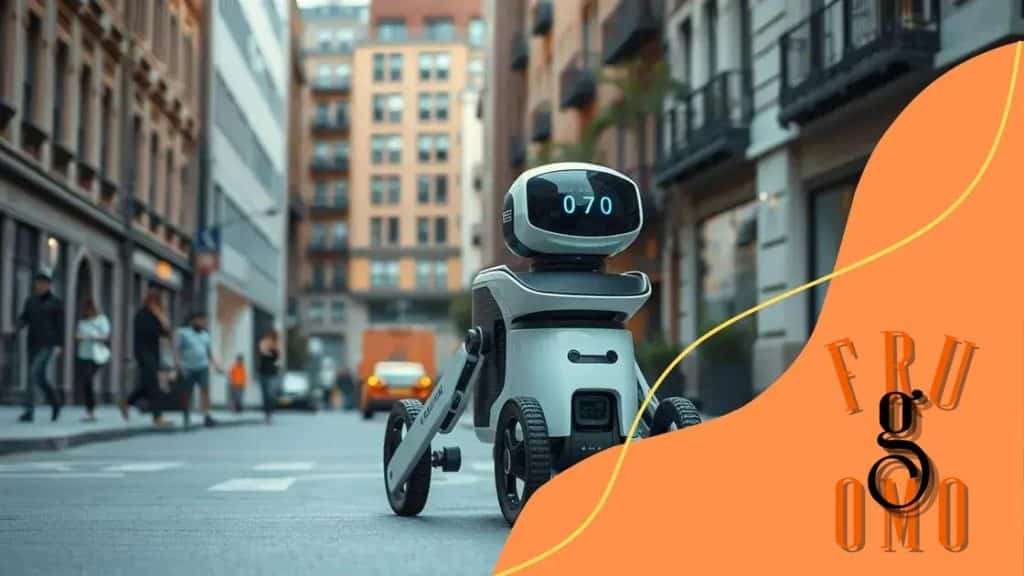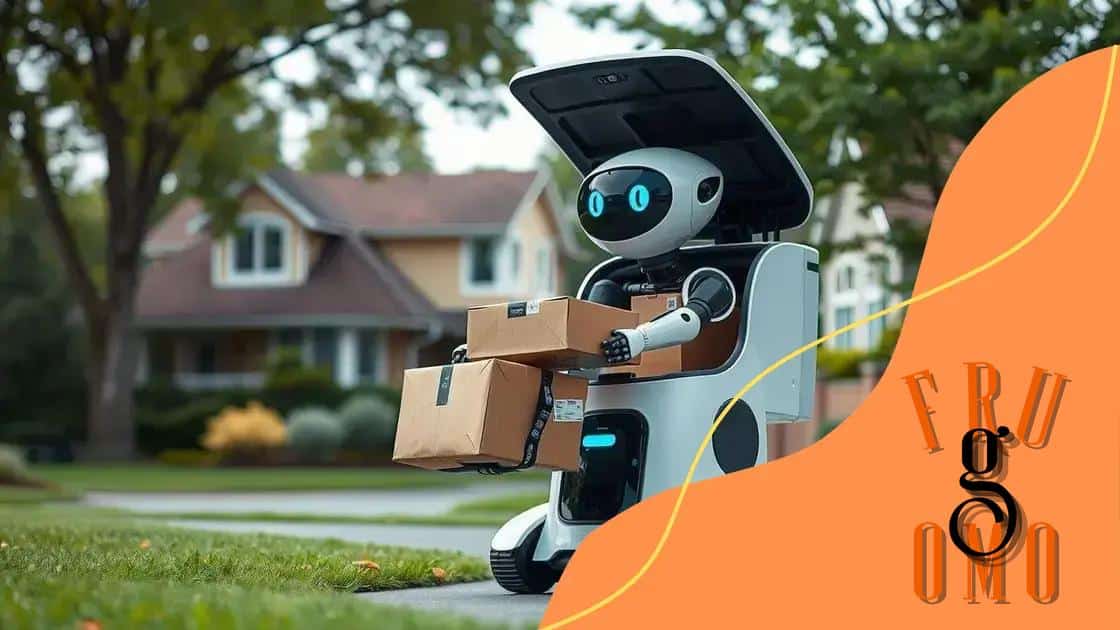Autonomous delivery robots in urban areas are changing delivery

Autonomous delivery robots in urban areas are self-navigating devices that transport goods efficiently, improving delivery speed, reducing costs, and benefiting the environment, despite challenges like navigation, public acceptance, and legal regulations.
Autonomous delivery robots in urban areas are revolutionizing how we think about deliveries. Have you noticed these robots zipping around your neighborhood? They promise convenience, but what does that mean for our cities?
What are autonomous delivery robots?
In recent years, autonomous delivery robots have emerged as a game-changer in urban logistics. These robots are designed to transport goods securely and efficiently without human intervention. But what exactly are they?
Understanding Autonomous Delivery Robots
Essentially, these robots are small, mobile devices equipped with advanced navigation and sensing technology. They use sensors, cameras, and artificial intelligence to navigate streets and sidewalks safely.
Key Features of Delivery Robots
- Navigation Technology: They typically use GPS and laser scanning to understand their surroundings.
- Load Capacity: Most delivery robots can carry small packages, usually weighing up to 5-10 pounds.
- Safety Measures: Equipped with obstacle detection, they can stop to avoid accidents.
- User Interaction: Customers can track the robot in real-time via a smartphone app.
Moreover, the growing popularity of e-commerce has driven demand for such innovative solutions. Consumers are looking for fast and reliable delivery options. These robots promise to deliver goods quickly while navigating through busy urban environments.
In summary, autonomous delivery robots blend technology and efficiency, offering a new perspective on how deliveries might evolve in urban settings. Their use not only saves time but also reduces traffic congestion, making cities more navigable for everyone.
The rise of autonomous delivery in cities
The rise of autonomous delivery in cities is transforming how goods are transported. As urban populations grow, the demand for efficient delivery methods increases. This trend has led to the development of innovative solutions like delivery robots.
Factors Contributing to the Rise
Several factors support the growth of autonomous delivery systems. First, advancements in technology have enabled more reliable navigation and control systems. This improvement means robots can safely travel through busy streets.
Benefits of Autonomous Delivery
- Efficiency: These robots can deliver items faster than traditional methods.
- Cost-effective: Reduced labor costs lead to lower delivery fees.
- Environmentally friendly: Many robots run on electric power, reducing emissions.
- Accessibility: They can reach areas that are hard for vehicles to access.
Another important aspect is the increasing preference for contactless delivery, which emerged during the pandemic. Customers appreciate the convenience of not needing to interact with a delivery person, and autonomous robots fit this need perfectly. They arrive at the specified location, notify the customer, and allow for easy retrieval of packages.
The future looks promising as cities continue to embrace innovative solutions. Local governments are also adapting regulations to facilitate the use of these robots on public roads. As more people become familiar with autonomous delivery, we can expect to see even more integration into daily life.
Benefits of using delivery robots

Using delivery robots offers numerous benefits that enhance both the customer experience and logistics efficiency. These robots are becoming essentials in our modern cities.
Key Advantages of Delivery Robots
First and foremost, the efficiency they bring to the delivery process is remarkable. They can operate continuously without breaks, delivering packages faster than traditional methods. This capability helps meet the rising demand for quick deliveries.
Cost Savings
- Reduced Labor Costs: Delivery robots minimize the need for human couriers.
- Lower Operational Costs: They usually require less maintenance than vehicles.
- Time Efficiency: Faster deliveries lead to more satisfied customers.
- Accessibility: Robots can reach areas that are difficult for trucks to access.
Additionally, they contribute to sustainability efforts. Most delivery robots are electric, which means they produce fewer emissions compared to delivery trucks. This eco-friendly approach aligns with the growing demand for greener solutions in urban logistics.
Another significant benefit is the enhanced customer experience. Consumers enjoy tracking their deliveries in real time through apps, making the whole process transparent and user-friendly. This technology allows customers to see exactly when their items will arrive, adding a level of convenience that was previously unavailable.
In summary, the advantages of using delivery robots go beyond mere convenience. They offer cost savings, environmental benefits, and improvements in customer satisfaction, changing how we think about deliveries in our cities.
Challenges faced by delivery robots in urban settings
Delivery robots face various challenges when operating in urban settings. Despite their potential, these obstacles can affect their efficiency and overall effectiveness.
Navigation and Obstacle Avoidance
One significant challenge is navigating through crowded streets. Urban environments are often bustling with pedestrians, cyclists, and vehicles. This unpredictability makes it hard for autonomous delivery robots to move freely without causing accidents.
Weather Conditions
Weather can also pose a problem. Rain, snow, and strong winds can disrupt safe navigation. Delivery robots need to be equipped with technology that allows them to operate in various weather conditions, which adds to their complexity.
Legal and Regulatory Hurdles
Additionally, there are legal and regulatory challenges. Many cities have not established clear guidelines for the operation of delivery robots. This uncertainty can lead to restrictions or delays in deployment, limiting the areas where they can operate.
Public Acceptance
- Familiarity: Some people may not be comfortable with robots making deliveries.
- Security Concerns: There are fears about theft or damage to the robots.
- Job Loss: Many worry about robots replacing human workers in the delivery industry.
- Perception: Public perception can heavily influence the acceptance of this technology.
Furthermore, the design of delivery robots needs continuous improvements to handle these challenges. Enhancements in sensors, cameras, and artificial intelligence can help robots better understand their surroundings. As technology improves, we can expect solutions to these challenges, enabling delivery robots to become an integral part of urban logistics.
The future of autonomous delivery services
The future of autonomous delivery services looks incredibly promising. With rapid advancements in technology, these services are on the brink of becoming a common part of everyday life.
Technological Innovations
Continued improvements in artificial intelligence and robotics will enhance the capabilities of delivery robots. They will be able to navigate complex urban environments more easily, avoiding obstacles and making real-time decisions.
Integration with Infrastructure
Smart city initiatives are also paving the way for better integration of delivery robots into urban areas. With the development of smart traffic signals and dedicated lanes for robots, we can expect smoother operations. This collaboration will help solve some current challenges, such as congestion.
The Role of E-commerce
As more consumers turn to online shopping, the demand for fast and reliable delivery options will continue to rise. Autonomous delivery services can meet these demands by speeding up delivery times and reducing costs.
Potential Challenges Ahead
- Legal Regulations: New laws will need to adapt to accommodate these technologies.
- Public Acceptance: Growing familiarity will help ease initial hesitations.
- Security Concerns: Addressing theft and vandalism of delivery robots will be crucial.
- Maintenance Requirements: Continued upkeep will be necessary to ensure reliability.
Moreover, the impact on the job market will be significant. While automated delivery should provide convenience, it may also lead to job shifts within the logistics industry. However, there may be new opportunities in robot maintenance and operation.
In summary, as technology advances and urban infrastructure becomes more supportive, the potential for autonomous delivery services to become a staple in our daily lives increases. Their evolution could reshape how goods are delivered forever.
FAQ – Frequently Asked Questions about Autonomous Delivery Robots
What are autonomous delivery robots?
Autonomous delivery robots are small, self-navigating devices designed to transport goods without human intervention, using sensors and artificial intelligence.
How do delivery robots improve delivery speed?
Delivery robots can operate continuously and navigate directly to their destination, significantly reducing the time it takes for packages to reach customers.
What are some challenges faced by delivery robots in cities?
Challenges include navigating crowded streets, adverse weather conditions, legal regulations, and public acceptance of robot deliveries.
How can autonomous delivery robots benefit the environment?
Many delivery robots are electric, leading to lower emissions compared to traditional delivery vehicles, thus contributing to a more sustainable urban environment.





